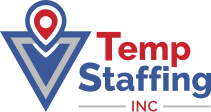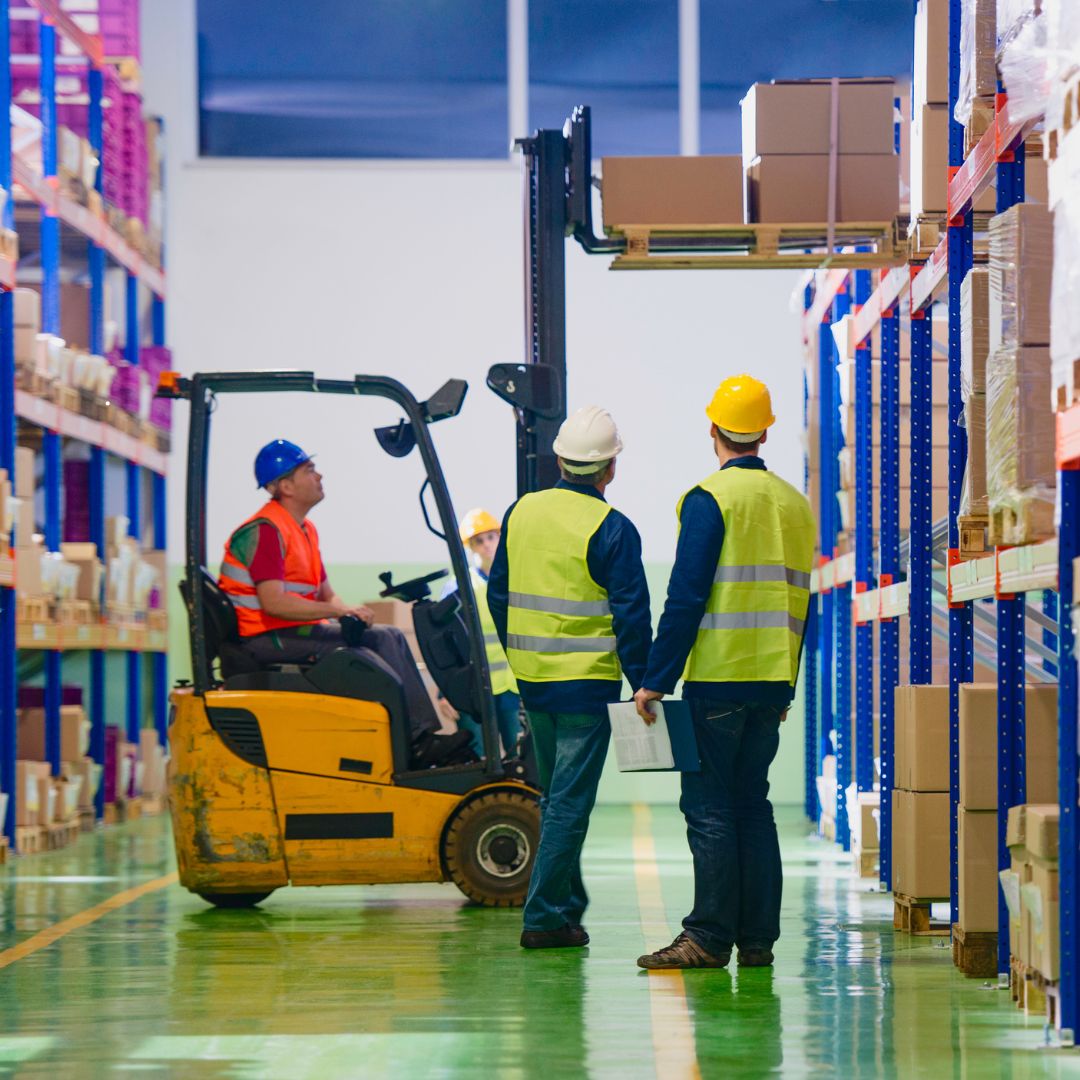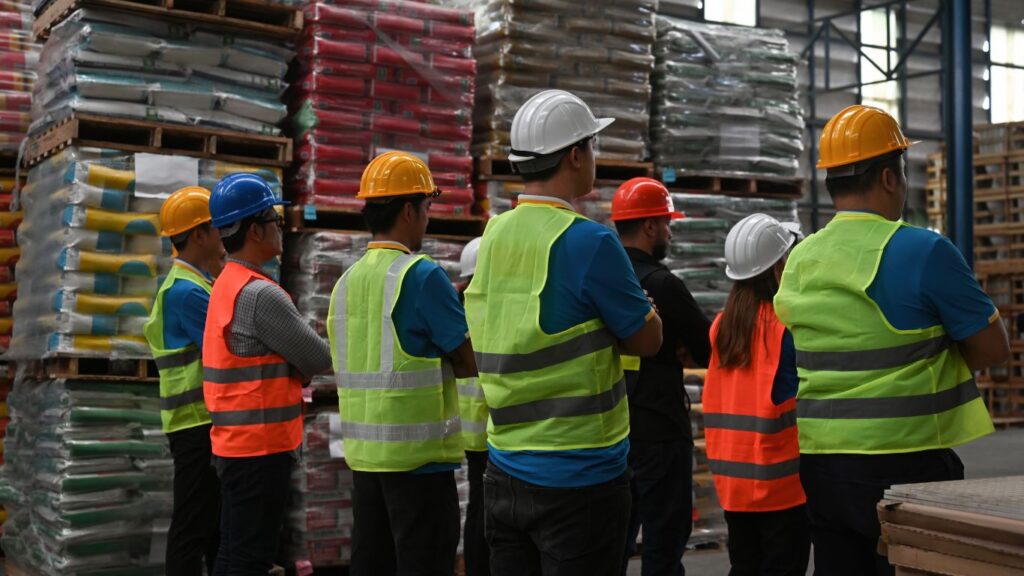Warehouse work, while essential, can be a dangerous endeavor. From heavy machinery to hazardous materials, the potential for accidents is high. But fear not! Implementing a few key warehouse safety strategies can transform your warehouse into a safe haven for your workforce.
In this article, Temp Staffing Inc. will show you how to ensure warehouse safety practices and expand on the warehouse safety tips outlined below. With nearly 25 years of hands-on experience in logistics, warehousing, and storage, we’ve tackled the toughest staff challenges head-on. We know what it takes to find not just workers but reliable, skilled professionals who can keep your operations running smoothly and safely.
Leverage A Safer Workforce With Temp Staffing Inc. Today!
Comprehensive Training Programs
Training is the backbone of a safe workplace. Employees should be thoroughly trained not only on their specific tasks but also on warehouse-wide safety protocols. Well-trained workers are more aware of potential hazards and better equipped to handle emergencies.
Studies indicate that companies with structured warehouse safety training programs experience 53% fewer workplace incidents. Warehouse safety training should cover as many essential warehouse safety tips as possible.
Proper Lifting Techniques and Ergonomics
Lifting injuries are a top concern in warehouse settings, often leading to serious musculoskeletal disorders. Training employees on proper lifting techniques, like bending at the knees, keeping a straight back, and holding loads close to the body, helps distribute weight safely and reduces strain. Practices in proper ergonomics also ensure that workers can lift, carry, and move materials with minimal risk of injury, making a huge difference in long-term health and productivity.
Safe Operation of Forklifts and Equipment
Forklifts are powerful tools, but improper use can lead to severe accidents. Every year, forklift mishaps result in significant injuries that are largely preventable with thorough training and certification programs. By ensuring operators know how to handle these machines safely and follow protocols, companies can create a safer environment for everyone on the warehouse floor.
Hazard Identification and Reporting Procedures
Encouraging workers to identify and report hazards proactively is a cornerstone of warehouse safety, including fire safety. According to Heliyon, environments with strong hazard-reporting systems experience fewer severe injuries. When employees feel comfortable sharing potential risks or near-miss incidents, managers can address issues before they lead to accidents, fostering a culture where warehouse safety is truly a shared responsibility.
Personal Protective Equipment (PPE)
PPE is a simple but vital layer of defense against many hazards that warehouse workers face daily. The Occupational Safety and Health Administration (OSHA) mandates the use of appropriate personal protective equipment, which can reduce injury risks when correctly implemented.
Steel-Toed Boots
These heavy-duty boots are essential for workers in construction, manufacturing, and other high-risk environments. They feature reinforced toes that act as a shield, protecting feet from heavy objects that might fall, roll, or even crush. Beyond impact protection, many steel-toed boots also offer slip resistance, adding an extra layer of warehouse safety on slick or uneven surfaces.
Hard Hats in Designated Areas
When working in areas where overhead hazards exist, hard hats are critical. These helmets absorb impact and provide a buffer against traumatic head injuries from falling objects or even accidental bumps against hard surfaces. These fall protection systems are a simple, effective way to protect one of the most vulnerable parts of the body.
High-Visibility Vests
In bustling worksites with lots of machinery or low-light conditions, high-visibility vests make workers more noticeable, helping prevent collisions and accidents. These brightly colored vests, often with reflective strips, ensure that every worker stands out, which is especially vital near roadways or construction zones with heavy equipment in motion.
Safety Glasses
Eye injuries are a common workplace hazard, with roughly 2,000 injuries reported daily. Workplace safety glasses, goggles, and face shields act as a barrier, protecting against flying debris, sparks, and harmful chemicals. The Occupational Safety and Health Administration (OSHA) recommends eye protection as a first line of defense, helping workers avoid painful and often preventable eye injuries.
Gloves for Handling Materials
Hands are exposed to countless warehouse safety hazards on the job, from sharp materials to toxic substances. Protective gloves come in various types (cut-resistant, heat-resistant, and chemical-resistant), each designed to guard against specific dangers. They help prevent cuts, burns, and contact with harmful chemicals, making them indispensable for workers handling tough or hazardous materials.
Leverage A Safer Workforce With Temp Staffing Inc. Today!
Equipment Maintenance and Inspections
A proactive approach to equipment upkeep is key to a safe workplace. Regular maintenance and inspections keep everything running smoothly and help identify wear and tear before it leads to failures that could cause accidents.
Forklifts and Powered Industrial Trucks
These heavy-duty machines are the workhorses of many warehouses and construction sites, but their sheer power demands careful oversight. With nearly 34,900 serious forklift-related injuries each year, it’s clear that routine maintenance is a must. Inspections help detect issues like worn brakes, malfunctioning hydraulics, or steering problems before they escalate.
Conveyor Systems
Conveyor systems are the backbone of material handling in many facilities, making it easy to transport products quickly and with minimal physical effort. However, conveyor belts and mechanical components can wear out or malfunction, leading to sudden stops, jams, or accidents if left unchecked. Routine safety inspections can spot early signs of wear or potential malfunctions, reducing the risk of injury and keeping materials flowing smoothly through the system, ensuring operations remain safe and on schedule.
Racking and Shelving Units
When it comes to storage, stability is everything. Racks and shelving units are often loaded with heavy materials, and even a slight imbalance can cause them to tip or collapse, posing a serious danger to workers. Regular stability checks ensure that racks and shelves remain secure and can handle the weight placed on them, minimizing the risk of accidents and providing peace of mind to those working nearby.
Loading Dock Equipment
Loading docks are high-activity zones where workers and deliveries come together in a whirlwind of movement. From unloading trucks to organizing goods, this area is a prime spot for slips, trips, and falls. Maintaining dock equipment like dock levelers, bumpers, and gates helps prevent accidents in these bustling zones. Well-maintained loading docks not only make the environment safer but also improve the flow of goods, supporting both warehouse safety and productivity in one of the busiest areas of any facility.
Clear Traffic Management
In a busy warehouse, coordinating the flow of people and vehicles is key to creating a safe, efficient workspace. Proper traffic management not only keeps operations moving smoothly but also significantly reduces the risk of collisions and accidents in high-traffic areas.
Designated Pedestrian Walkways
Marked pedestrian walkways serve as dedicated safe zones for employees on foot, giving them a protected path through high-traffic areas. These walkways create a clear separation between people and equipment, ensuring that workers don’t end up in the path of a fast-moving forklift. By directing foot traffic through safer routes, pedestrian walkways allow employees to navigate the warehouse with confidence, even when heavy machinery is nearby.
Vehicle Traffic Lanes and Speed Limits
Just as on roads, assigned lanes and speed limits in a warehouse are crucial for safe vehicle movement. Setting specific paths for forklifts and other industrial vehicles prevents them from straying into unexpected areas, reducing the chance of sudden encounters with pedestrians or other vehicles. Speed limits, meanwhile, keep vehicle operators focused and in control, minimizing the chance of high-speed incidents.
Stop Signs and Yield Areas
In a fast-paced warehouse, intersections can be high-risk zones where traffic paths cross and visibility can be limited. Strategically placed stop signs and yield areas at these junctions help prevent accidents, giving operators and pedestrians clear guidelines on when to pause or give right of way. This structured approach keeps the flow of traffic smooth and organized, allowing everyone to navigate safely without unnecessary stops or risky dashes.
Leverage A Safer Workforce With Temp Staffing Inc. Today!
Proper Material Storage
Safe storage practices are essential in any warehouse job to prevent accidents and create an organized, accessible workspace. When materials are stored correctly, there’s a lower risk of items falling, collapsing, or causing injury to workers.
Secure Unstable Items
Awkward, loose, or stacked items are prone to shifting, especially in high-traffic areas where vibrations and movement are constant. When unstable items are left unsecured, they can easily tip or fall, posing a serious hazard to workers below. Using straps, nets, or securing barriers ensures these items stay firmly in place, giving workers peace of mind as they move around the space and reducing the chance of accidents caused by falling items.
Do Not Overload Shelves or Racks
While it might be tempting to push storage capacity to the limit, overloading shelves or racks can lead to dangerous collapses that put both people and equipment at risk. Each rack has a weight limit designed to keep it stable under regular conditions. Exceeding these limits can strain the materials, making them prone to bending, buckling, or even sudden collapse.
Keep Heavier Items on Lower Shelves
Heavy items stored on upper shelves increase both the physical strain on workers and the risk of accidents. When these items are placed on lower shelves, it improves stability by keeping the center of gravity low, reducing the chance of tipping or unbalanced racks. This approach also makes it easier and safer for workers to lift and move heavy items, minimizing the risk of strain injuries or accidents caused by dropping.
Ergonomic Workstations
Ergonomic improvements help reduce physical strain on workers, making it easier to maintain productivity while reducing injury risks. In warehouses, ergonomic adjustments have been shown to decrease musculoskeletal injuries by up to 50%.
Adjustable Work Surfaces
One-size-fits-all doesn’t apply in ergonomics. Adjustable work surfaces allow workers to tailor their workstation height, whether they’re sorting, packing, or assembling items. This simple but impactful adjustment prevents the need for awkward bending or reaching, reducing strain on the neck, shoulders, and back. By enabling workers to set up a workspace that fits their body and task, adjustable surfaces make daily tasks more comfortable and efficient.
Anti-Fatigue Mats
In a warehouse, many workers spend hours standing, which can lead to significant fatigue and discomfort in the feet, legs, and lower back. Anti-fatigue mats are specially designed to provide cushioning that reduces pressure on joints and muscles. This subtle support keeps employees feeling energized and reduces the risk of soreness and injuries associated with prolonged standing.
Mechanical Assists for Lifting
Repeated heavy lifting is a major contributor to workplace injuries, particularly in warehouses. Mechanical assists like lifts, pulleys, and hydraulic jacks are powerful ergonomic tools that take the strain off workers’ backs and shoulders by handling much of the heavy lifting. These devices allow employees to move heavy items with minimal physical effort, lowering the risk of back strain and injuries associated with overexertion.
Leverage A Safer Workforce With Temp Staffing Inc. Today!
Regular Safety Audits
Safety audits are an ongoing process that identifies potential hazards and assesses adherence to warehouse safety protocols.
Identify Potential Hazards
Conditions in a busy workplace can change quickly, and new hazards can emerge without warning. Regular walkthroughs during warehouse safety audits allow managers and safety officers to spot any evolving risks, from cluttered walkways and damaged equipment to updated layouts that may introduce new dangers. By identifying hazards early, audits allow teams to address issues before they cause harm, ensuring a safer, more controlled environment.
Ensure Compliance
It’s one thing to have warehouse safety protocols in place; it’s another to ensure they’re followed consistently. Audits are a great way to reinforce these standards and hold everyone accountable. They confirm that warehouse employees are using the correct equipment, following proper safety procedures, and maintaining safe behaviors. When everyone knows that adherence to safety protocols is regularly monitored, they’re more likely to follow them, creating a safer and more disciplined workplace.
Recognize Good Safety Practices
Positive reinforcement is a powerful tool for building a culture of warehouse safety. Safety audits aren’t just about identifying problems; they’re also an opportunity to acknowledge warehouse employees who are doing things right. Recognizing team members for following procedures and maintaining safe workspaces encourages others to do the same, strengthening overall compliance and building morale.
Incentive Programs
Incentive programs play a crucial role in promoting warehouse safety and enhancing employee retention by motivating employees to engage in proactive behaviors, fire safety measures, and hazard communication. Rather than simply tracking injury rates, rewarding actions like near-miss reporting and regular safety training completion focus attention on preventing accidents before they occur. Near-miss reports act as an early-warning system, helping teams address risks while fostering a culture that views close calls as learning opportunities rather than failures. Additionally, encouraging warehouse safety suggestions empowers frontline employees to share practical insights, driving continuous improvement.
Conclusion
Building a culture of warehouse safety is more than following protocols; it’s a commitment to protecting every team member. By implementing these strategies, you can create a warehouse environment where safety is second nature, ultimately benefiting both your workforce and your bottom line.
Finding dependable, warehouse safety-focused workers has always been a struggle, so we set out to solve this challenge for the entire industry. At Temp Staffing Inc., we fill vacancies and ensure that every candidate undergoes a thorough screening, employee training, and onboarding process.
This guarantees that each team member is fully prepared to meet warehouse safety standards, helping your warehouse operate smoothly, efficiently, and with a workforce you can trust.




